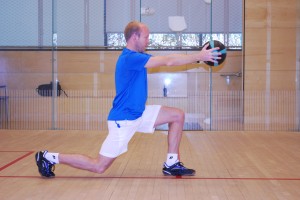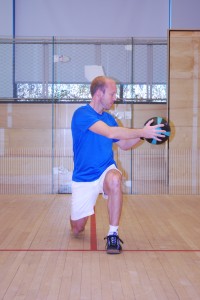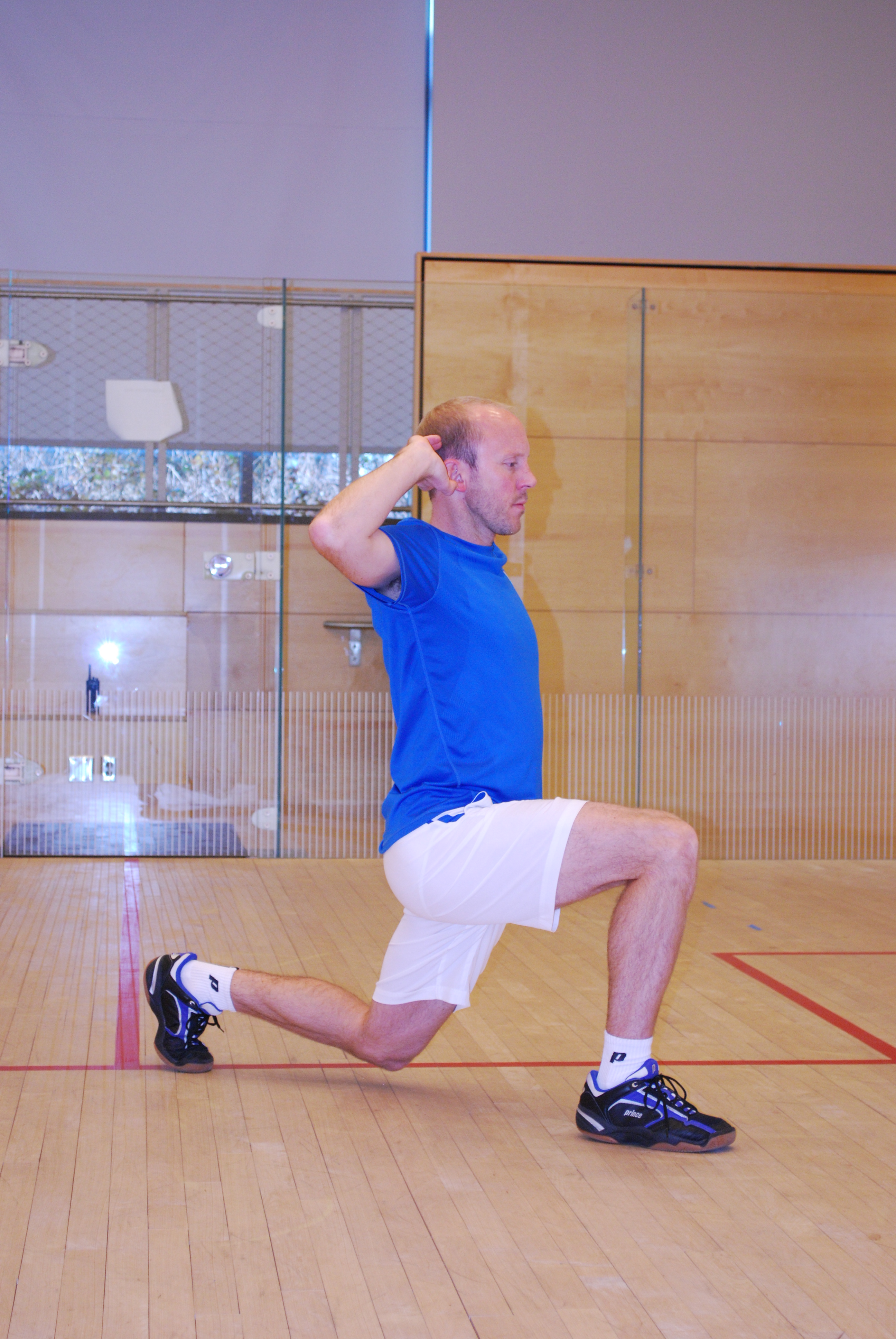By Damon Leedale-Brown, Sports Scientist & Conditioning Specialist
Last month we focused on single leg strength with two exercises that, if performed consistently as part of a structured strength program, can be effective in improving a player’s ability to move with control and balance around the squash court, particularly when transferring weight from one leg to another as in a lunge.
The lunge is a key part of squash movement and one that many players find difficult even in a controlled environment off court, let alone in the dynamic and ever changing environment on the squash court. It is not uncommon to watch a match and see players collapsing over the ball with the upper body when they try and lunge; falling through the shot so they effectively travel beyond where the ball was hit; or losing balance and control as they try and come out of the lunge. Think about playing a long five set match and the number of times within the match that you will have to perform a lunge of some type as you move on and off the ball. It is easy then to understand why the lunge is such an important movement on the squash court!

With all levels of players I have a series of different lunge patterns that I use within their training programs. Many are initially performed as body-weight exercises with younger players, or for older players who are just embarking on a strength program. Here are some examples:
X-Over Lunge
A good exercise to help improve rotational control as you pivot into a hitting position:
- Stand with feet hip width apart.
- With your right foot step across your body at an angle (approx. 45 degrees) into a lunge.
- As you step across with the right foot, let the left foot pivot naturally as you turn into position.
- Push out strongly with the right leg and let the left foot pivot back as you return to standing with both feet facing forward again.
- Repeat the above sequence with your left leg across to the right side of your body.
- Perform 5-8 lunges on each leg, or for a set time (i.e., 30-40 seconds) as part of a circuit.
- Start with body weight and hands held to the side of your head. Progressions can be made with a medicine ball held into your chest and pressed out ahead of your body as you step into the lunge. This adds an extra element of deceleration control into the movement.
Backwards Lunge
Many players struggle with recovery of movement backwards out of the front corners. This exercise can help improve their ability and control in such movements:
-

The Backwards Lunge will help with recovering from shots into the front corners. When performing lunges, finish with the knee of the front leg above the ankle and the thigh parallel to the floor. For both, start in a standing position. Stand with feet hip width apart.
- Step backwards with one leg as you balance on the other leg.
- Focus on reaching back with the leg so you step back far enough to lower into a strong lunge position with the heel of the back foot off the ground.
- Finish in a position where the knee of the front leg is above the ankle, the knee of the rear leg is just above the floor (not touching), and the shoulders finish above and not forward of the hips.
- Push strongly from the back foot to return to a standing position, and then repeat with the other leg.
- Perform 5-8 lunges on each leg, or for a set time (i.e., 30-40 seconds) as part of a circuit.
- Start with body weight and hands held to the side of your head. Progressions can be made with a medicine ball pressed out ahead of your chest as you step back into the lunge, or held overhead to introduce an additional challenge.
- This exercise can also be performed as a walking backwards lunge.
Walking Lunge with Twist
A good exercise to help a player develop their ability to turn across the hips with the upper body while demonstrating excellent stability and control with the lower body.
-

The Walking Lunge with Twist is designed to help players develop their ability to turn across the hips with the upper body while maintaining stability and control with the lower body. From the starting position, step into a lunge (with knee over ankle), then twist your upper body over the lead leg followed by twisting away from the lead leg. Return to the central position by continuing through, then lunging forward with the opposite leg and repeating the process. Perform on a squash court in or in an open space in the gym.
- Step forward into a lunge.
- With the arms held in front of the body twist your upper body over the lead leg, and then turn and twist away from the lead leg.
- Return to a central position with arms in front of the body and then step through into the next lunge to repeat the sequence.
- Walk length of court (or 6-8 lunges), turn and repeat back down court after a short rest.
- Progression can be made with medicine ball held slightly in front of body, and turn with ball across both hips as above.
- Can also be performed as backwards walking lunge with twist.
Performed with good technique, lunges and in particular lunge walks will tend to place more stress on the legs than many players are used to (as they do not lunge that well on court!). With the lunge walks I will often have players comment on a sensation of feeling tight or sore in the groin (almost like a pulled muscle). This is because the long adductor muscles in the groin have been worked harder than they are typically used to. The backward lunge walks tend to place less stress on the long adductors than the forward lunge walks so may be a better place to start for many players. Indeed as with any new strength exercise, start gradually and then build up your number of reps and sets and external resistance as your body adapts to the new training stimulus.
We have now covered a good range of leg strength exercises that can be introduced appropriately into any well-structured strength training program for a squash player. In our next article on strength we will begin to look at how to develop hip and torso strength. Enjoy lunging!





